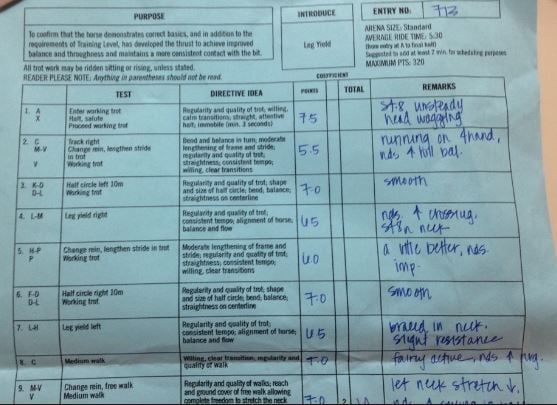 One of the best ways to improve your dressage scores is to volunteer to scribe for a judge at a dressage show. This gives you a front-row seat to see the ride and hear how the judge scores it. It can help you learn just what the judge’s are looking for in each movement. Not only will you hear the number score, you will also hear any comments the judge makes as to why they scored the movement the way they did.
One of the best ways to improve your dressage scores is to volunteer to scribe for a judge at a dressage show. This gives you a front-row seat to see the ride and hear how the judge scores it. It can help you learn just what the judge’s are looking for in each movement. Not only will you hear the number score, you will also hear any comments the judge makes as to why they scored the movement the way they did.
The Scribe is the person who sits beside the judge during each ride and writes the judge’s score and comments onto the test sheet. The Scribe must be able to record the judge's comments accurately and consistently. While the numbers indicate the score, the remarks will most often tell you why you received that number or what you need to work on.
You will be required to sit quietly and concentrate for several hours just listening and writing. The time commitment is typically four hours, but some judges prefer to have the same scribe all day. At the end of the test, the Scribe gives the completed and signed test sheet to a runner who takes it for official scoring.
 A Scribe should have familiarity with dressage and the terms that may be used during a test. They must be able to record the judge’s score and remarks quickly, clearly and legibly. Scribes must maintain confidentiality and make no remarks about any horses or riders in the competition, including but not limited to, any background information about the horse or rider, their trainer/coach, breeding, etc. Above all, a Scribe must never repeat any of the judge's remarks.
A Scribe should have familiarity with dressage and the terms that may be used during a test. They must be able to record the judge’s score and remarks quickly, clearly and legibly. Scribes must maintain confidentiality and make no remarks about any horses or riders in the competition, including but not limited to, any background information about the horse or rider, their trainer/coach, breeding, etc. Above all, a Scribe must never repeat any of the judge's remarks.
In addition, the Scribe helps the judge prepare for each test. At the start of each class (ex. Training Level, Prix St. Georges), be sure the judge knows what test is being performed. A spare copy of the test should be available for the judge if they need to refresh their memory. Be sure that everything the judge needs is available. This can include a copy of the ride time schedule, pens/pencils, test sheets, whistle or bell and water/coffee if the judge prefers.
Before the first ride, discuss with the judge how he/she prefers to report scores and comments. Establish clearly whether comments for a movement will be given before or after the score so that comments will be entered in the proper place. Establish whether the judge wants comments abbreviated or will not accept abbreviations. If judge allows such, use abbreviations as much as possible. You should not talk to the judge during a ride. However, if you get lost on the correct movement being scored, quietly ask what movement the next score will be for.
As the rider enters the arena, check each rider's number, confirming it with the number on the test sheet. If the numbers do not match, find out who the rider is and locate the proper test sheet. Write the judge's comments exactly as given. Do not rearrange or edit. At the conclusion of the test, but before giving the score sheet to the runner, review what you’ve written reflects what the judge said. Double check that the test includes all required scores, that errors are clearly marked and that the judge has signed the test score sheet. Some judges may wish to write their own note to the competitor on the bottom of the test, or may dictate them to you.
The United States Dressage Federation (USDF) has put together a list of guidelines for Scribes. Click HERE for a copy. Note, too, that it lists the most common abbreviations used when scribing. With the permission of the judge, use this to make your job easier and more efficient.



